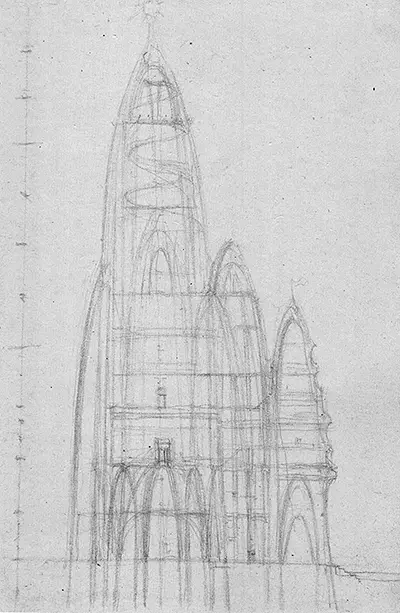Antoni Gaudi studied Architecture in Barcelona in Spain, where romantic and neo-classic designs greatly surrounded him. He became popular by reinterpreting the designs and working in the Art Moderne and Art Nouveau styles, and Barcelona's Sagrada Familia is considered to be his greatest work.
Two unknown American businessmen really admired Antonio's unique vision, and so they requested him to design a hotel, which would be located in Lower Manhattan. Antonio designed multiple 980 – 1000-foot-high sketches known as the Hotel Attraction (Hotel Atraccion). It contained lavishly appointed conference and guest rooms, an exhibition hall, a large lecture hall and theatre, an exhibition space of 390-foot, multiple galleries, 5 dining rooms symbolising the 5 continents, and 6 floors of restaurants. The top of the tower is star-shaped, and it could give 30 persons at a time non-obstructed views of this beautiful city. Had this hotel been built, it would definitely have been New York City's tallest building. Unfortunately, the hotel would never be built.
Carlton wanted the building to serve the most elite and wealthiest clientele in the city. Antonio, a communist, completely disagreed with the desires of the businessmen to cater to the fortunate or wealthy, and he abandoned this project on principle. Another, less dramatic tale, says that in 1909, Antonio fell ill, thus canceling the project. Most people firmly believe that this futuristic hotel was just unrealistic for the time. This project actually remained unknown until when a report by Joan Matamala I Flotats was published in 1956, referred to as When the New World called Gaudi.
The Hotel Attraction never progressed beyond the drawing boards; however, there some reasonable efforts by ardent Antonio fans championing the building as the perfect replacement for Barcelona's Twin Towers just after 9/11. You should also know that Gaudi's organic, modern style is still fresh today, just as it was a hundred years ago. The spaceship-like building was featured in Fringe, a Fox Broadcasting TV show. A group of architects from Spain submitted plans into the World Trade Center design competition back in 2003. His cathedral is being built in the city of Barcelona. Also, in 'alternate universe' Antonio's building looks spiffy.
What Inspired Antoni's Work?
'Originality is returning to origin' is one of his most often-repeated and most famous phrases. For Antoni, this origin was simply nature – trees and living plants. The deeply religious man viewed the natural planet as perfect, a magnificent creation from which he drew creativity or inspiration. The connection is clearly visible in Gaudi’s masterpiece, Sagrada Familia. Gaudi was also inspired by the colours therein. The elements found in his biomimetic architecture, sometimes known as nature-inspired work, can be classified as structural or ornamental.
Antonio has also inspired and fascinated generations of designers, engineers, and architects. Today, Gaudi's work entices many following with some of the most recognisable, idiosyncratic, and distinctive designs of all time. Other great Gaudi works include Casa Mila, Park Güell, Casa Batllo, Church of Colonia Güell, Episcopal Palace of Astorga, Güell Palace, Casa de los Botines, Casa Vicens and Casa Calvet.




